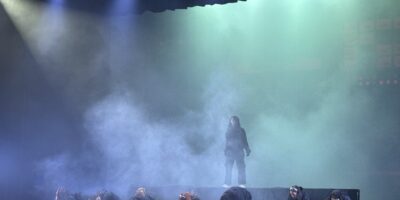Hello readers (and especially first years)! For those of you reading our column for the first time we are Rebecca Cameron (4A Geological Engineering) and Eric Cousineau (4N Electrical Engineering), the writers of Beer Buzz. Our tastes are pretty different – Rebecca prefers stouts and dunkels, while Eric likes ales and IPAs. As a couple, we have tried hundreds of different beers together and we have almost 60 unique beer glasses sitting on our shelves waiting to be filled with hoppy goodness! Our beer column looks at how to taste beer, pour beer, find good beer, different beer styles, and the history of beer. We hope that we can convince people to be more adventurous in their beer drinking decisions. There are some amazing imports and microbrews available, so don’t let the Beer Store’s Top Ten list make your beer choice for you!
This term we are in a unique situation – Eric is on co-op in Burnaby, BC while Rebecca is in Waterloo (working at the CnD a lot – so if you want to chat about beer go visit!). We will use Skype to ensure our beer tastings go the same as they do now, although Eric will be drinking West Coast brews and Rebecca will be drinking more local brews.
To help get you excited about beer, we decided to start off the column this term with some interesting random facts you may or may not know about beer. The world’s first consumer protection law was enacted in 1516 by Duke Wilhelm IV of Bavaria. It was a beer purity law (Reinheitsgebot in German) limiting the ingredients to barley, hops and water. While not technically in effect today, many German and Bavarian breweries still claim to comply with the law for marketing purposes.
Ever wonder if there’s a beer out there that can beat out wine in terms of alcohol percentage? The strongest beer in the world, called Triple Bock, is brewed by the Boston Beer Company (aka. Samuel Adams) and it rated at 17% alcohol by volume. The alcoholic strength is achieved by using champagne yeast in the fermenting process.
Popular opinion leads people to believe that canned beer is inferior to bottled beer, this is not true. Many people claim that the aluminum in the can changes the flavour of the beer, but this hasn’t been true since they started lining the cans with epoxy 40 odd years ago. Even in 1935, when canned beer was introduced, the cans were keg-lined to preserve the taste of the beer. On the other hand, bottles may not be all they’re cracked up to be since the nature of the container allows light to penetrate and oxidize the beer. Brewers have attempted to block the harmful wavelengths by using tinted glass (that’s why most beer bottles are brown), but the tint can only do so much. If exposed to too much light, the beer will oxidize and become was is commonly referred to as skunky.
Finally, according to Statistics Canada, as of 2007, there were 197 establishments brewing beer in Canada, 91 of which are in Ontario. According to the US brewers association, there were more than 1,525 breweries in the United States in mid-2009. So, enough facts – let’s get to some beer!
We kicked off our cross-Canada beer tour by ignoring Ontario completely – we wanted to try beers from other provinces, not the same old brews. So our first stop for new beer was in Winnipeg, Manitoba. After some struggles with the sketchiness and terrible driving Winnipeg had to offer us, we went out in search of beer. We found a really sketchy looking drive through beer store that was rather small. But we went in and found what we were looking for – the Fort Garry Brewing Company’s Pale Ale. It was brewed in Winnipeg, and the brewery happens to be Manitoba’s oldest micro-brewer (since 1930). Since no glasses were on hand we drank this from the bottle, and because of this we weren’t able to judge its appearance. The aroma was very grainy and metallic – we were hoping it would smell more hoppy. The taste was sweet and malty and as the beer warmed the taste of the hops became more apparent. Overall the beer was typical for a micro-brew, but since it was fresh it was an above average beer.
We then went to Regina, Saskatchewan and found a large liquor store. We picked up a six-pack of Great Western Brewing’s Original 16 Canadian Pale Ale brewed in Saskatoon and we quickly determined this was a long name for a beer that came up very short in taste. We had to drink it straight from the can and were seriously regretting not bringing our own beer glasses at this point. Again, skipping appearance,, this beer had a faint aroma of stale malt and musty hops. It tasted very bland and distinctly reminded us of the dreaded Beer Store Top Ten…except this time we were buying it in Saskatchewan where good grains should be abundant. Overall, we did not appreciate the beer at all, and would suggest avoiding it in the future.
We were then on the road again, this time to Calgary, Alberta. We found Amber’s Brewing Company’s Lunch Pail Ale brewed in Edmonton. The quirky design of the case was what inspired us to give it a shot. We drank it from the bottle, and loved the smell of this one – caramel and a hint of floral hops. The taste did not disappoint us either – very malty with some toffee and towards the end of the sip all you can taste is mild hops. This was a delicious, fresh and well-balanced ale, we both were quite happy to find a beer of this quality, especially because of the 12 hour driving day we had ahead of us the next day. We highly recommend this beer if you are in Alberta!
Next time Rebecca will report on Oktoberfest from the Concordia Club in Kitchener. We hope you all stay thirsty and (as always) fear no beer!
Photo Credit: Amber’s Brewing Co.




Leave a Reply